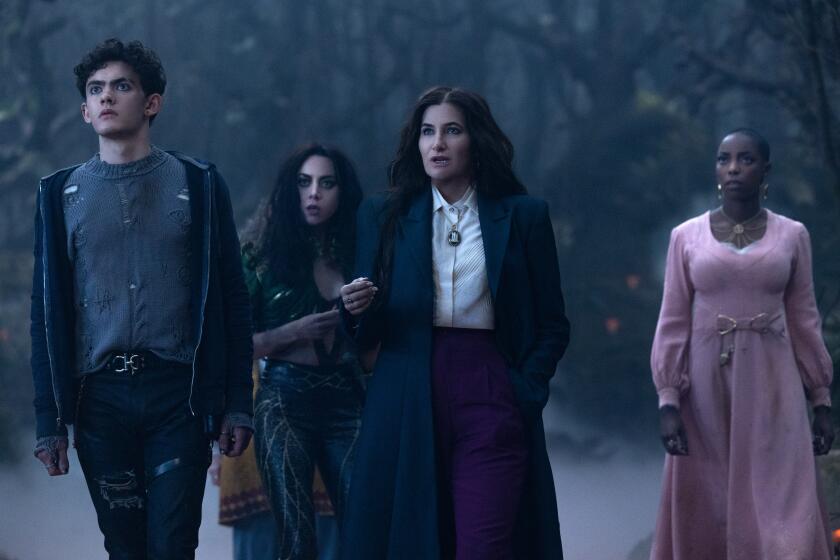Review: Los Angeles Chamber Orchestra won’t stand still
An orchestra of many moving parts, the Los Angeles Chamber Orchestra does not have a home. Besides its main orchestral series, it has a Westside chamber series, a Baroque series downtown and five fall exclusive foodie fundraisers in classy homes around town.
But that orchestral series, given on Saturday nights at the Alex Theatre in Glendale and Sunday nights in Royce Hall at UCLA, is LACO’s real bread and butter. This season’s opener, which I heard at Royce, was a showcase program, itself made up of many moving parts, within which there were more moving parts.
Even so, the orchestra also boasts stability. Music director Jeffrey Kahane is now in his 16th season. And Sunday, LACO, though long presented by UCLA, entered into a more meaningful relationship with the university. The campus’ Center for the Art of Performance (CAP), formally UCLA Live, has made LACO Royce’s orchestra in residence.
The program was, like LACO, all over the place. It began with a spectacular performance of Ravel’s jazzy Piano Concerto in G conducted from the keyboard by Kahane. Two recent pieces by young composers followed. Beethoven’s Violin Concerto, with Augustin Hadelich as soloist, was the major work and relegated to the second half.
Although probably a practical decision to reduce setup time, beginning with Ravel concerto didn’t make much musical sense, since Andrew Norman’s “The Great Swiftness” is an obvious curtain riser. Moreover, it served as an ear-perking introduction to the start of the 32-year-old composer’s three-year LACO residency.
The piece, given its premiere by the Grand Rapids Symphony two years ago (Norman is a native son), is an impression of Alexander Calder’s sculpture “La Grande Vitesse” that faces the town’s city hall. A Coplandesque salute in the winds and brass lost its ordinariness when it became material for echoing effects throughout the orchestra. Eventually this wound down to sliding tones in the strings.
Calder’s reddish orange masterpiece of public art is what the sculptor called a stabile, a monumental mobile-like structure that doesn’t move. Norman’s “Great Swiftness” supplied the motion not by turning a stabile into a mobile but by contributing a sense of wonder that made it feel as if the ground might shift slightly under your feet as you listen.
James Matheson’s “True South” was paired with Norman’s “Great Swiftness.” It too used the orchestra to make surprising sounds, if less enchanting than astonishing.
Born in Des Moines in 1970, Matheson has been quickly collecting major commissions. The Chicago Symphony and Los Angeles Philharmonic premiered his Violin Concerto last season. “True South” was commissioned for the New York Philharmonic’s new music series, Contact, and Alan Gilbert conducted it at the end of 2010. LACO, though, was more generous by allotting a considerably larger string section to Matheson than had the New Yorkers.
Matheson’s inspiration was Werner Herzog’s South Pole documentary “Encounters at the End of the World,” but the composer provided neither the grandeur nor the whimsy of the cinematic Antarctic encounters. The score had, instead, more of the aspect of an aggressive symphonic bestiary. I’ve always thought of the South Pole as a place of overpowering silent majesty. Matheson hears it as a landscape ripe for strange and fascinating guttural and esophageal instrumental effects carried on for 17 raucous minutes.
An interesting program might have been to have paired the hardy “True South” with Vaughn Williams’ grim “Sinfonia Antarctica” and free-falling “The Great Swiftness” with John Cage’s delicate “Works of Calder.” Rather, there were the two concertos.
Ravel’s vies with Rachmaninoff’s Second and Gershwin’s “Rhapsody in Blue” as the most popular 20th century piano concerto these days. Every few months a new recording of it is released. But not many performers, other than Leonard Bernstein and André Previn, have attempted to conduct Ravel from the keyboard.
Kahane’s performance was in their class. In the outer movements, he was pianist and bandleader in an Ellingtonian mode. Like Bernstein and Previn, Kahane’s jazz was more American-tinged than French. Suave syncopations swung with a natural flow. The tempos were swift. The orchestra cooked, reading Kahane’s mind and swinging with him as one. In the lyrical slow movement, Kahane showed his other side — that of eloquent Mozartean.
As for the Beethoven, Hadelich played the concerto with a slender tone and spotless intonation. He made a beautiful sound. But he was introspective not heroic, that essential Beethovenian ingredient left to Kahane to supply.
For an encore, Hadelich played Paganini’s 24th Caprice with an ethereal virtuosity that made it sound as if it could have been written by Ligeti. It was pure magic.
Not every violinist is right for Beethoven’s concerto nor needs to be. Hadelich belongs elsewhere, and perhaps in repertory closer to his own time. LACO, on the other hand, is a roamer, at home everywhere.
MORE:
CRITIC’S PICKS: Fall Arts Preview
TIMELINE: John Cage’s Los Angeles
More to Read
The biggest entertainment stories
Get our big stories about Hollywood, film, television, music, arts, culture and more right in your inbox as soon as they publish.
You may occasionally receive promotional content from the Los Angeles Times.











